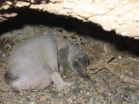Biologist Belovsky's paper offers new insights into predator/prey relationships
2011-04-09
(Press-News.org) For those old enough to remember Mutual of Omaha's "Wild Kingdom" television series, the dynamics of predator-prey relationships seemed clear enough: predators thinned out prey populations, which enabled a smaller, but stronger, population to survive and reproduce.
However, a new paper by University of Notre Dame biologist Gary Belovsky appearing in the prestigious journal Ecology Letters suggests that predator-prey relationships are much more complex than originally thought.
The paper arose out of pioneering studies Belovsky, who also is director of the Notre Dame Environmental Research Center (UNDERC), has been conducting on grasshopper populations since 1978 at Montana's National Bison Range, now a location for one of UNDERC's national undergraduate programs.
Belovsky conducted an experiment to examine how behavioral responses of grasshoppers to avian predators affected grasshopper survival and reproduction at different grasshopper population densities. A series of cages containing grasshoppers were enclosed within a tent constructed of aviary netting, creating a "no threat" area because its design prevented birds from approaching the cages and "scarring" the grasshoppers. A second set of cages provided a "threat" area because it was not enclosed in a tent, which allowed birds to feed around the cages, perch on top consuming grasshoppers caught outside the cages and "scare" the grasshoppers inside the cages.
The research demonstrated that grasshopper behavior changed with the threat of predators, reducing grasshopper feeding, and this was apparent at all grasshopper densities. The behavioral changes with the threat of predation increased survival at low grasshopper densities, as reduced feeding made food available to more individuals, while the changes decreased survival at higher densities, as severe food shortages were made worse by reduced feeding. However, the behavioral changes decreased per capita reproduction over all grasshopper population densities, as grasshoppers traded off survival and reproduction as competition among the grasshoppers increased with greater population densities.
This type of variable response is generally overlooked when prey behavioral changes with predation are considered in how predation affects prey populations," Belovsky said. "Resource availability may need to be considered when assessing how prey behavioral changes with predation threat affect population and food web dynamics."
Belovsky also notes that the new paper reinforces the importance of his western prairie research, which is now the longest running experimental study at a site examining what controls grasshopper populations. Although it isn't feasible to conduct a population study like this with populations of larger animals, such as elk and wolves in far-flung areas such as Alaska, the more easily observable field work with grasshoppers and birds offers important predator-prey insights that can be applied to these types of populations.
INFORMATION: END
ELSE PRESS RELEASES FROM THIS DATE:
2011-04-09
College Park, Md.—Nearly 5 million American children participate in the Boy Scouts and Girl Scouts, but until now no one has looked at the gender messages young people get when they start collecting those coveted badges.
Kathleen Denny, a sociology graduate student at the University of Maryland, College Park, analyzed scouting manuals and found that—despite positive aspects—today's scouts are being fed stereotypical ideas about femininity and masculinity. Her findings were recently published in Gender & Society, the highly-ranked journal of Sociologists for Women in Society.
Girl ...
2011-04-09
ST. LOUIS – Saint Louis University researchers have identified a novel mechanism to control the traffic of cells and fluid from tissues to lymphatic vessels. It may be possible to harness this mechanism to fight cancer spread from one organ to another organ and improve the effectiveness of vaccines.
The lymphatic system is an extensive fluid transit system, consisting of vessels in the body. It defends the body against infection. Cancer cells and infection-fighting cells that are part of the immune system use the lymphatic system to get to other organs, including the ...
2011-04-09
TORONTO, On – April 8, 2011 – Increased levels of a protein that helps regulate the body's blood pressure may also predict a major cardiovascular event in high-risk patients, according to a study led by St. Michael's Hospital's cardiovascular surgeon Subodh Verma. Measuring the amount of the protein, known as plasma renin activity (PRA), in the blood stream may give doctors another tool to assess a patient's risk and help prevent a heart attack or stroke.
"Conventional factors like genetics and environment do not always provide a complete patient story and an understanding ...
2011-04-09
A galaxy's core is a busy place, crowded with stars swarming around an enormous black hole. When galaxies collide, it gets even messier as the two black holes spiral toward each other, merging to make an even bigger gravitational monster.
Once it is created, the monster goes on a rampage. The merger kicks the black hole into surrounding stars. There it finds a hearty meal, shredding and swallowing stars at a rapid clip. According to new research by Nick Stone and Avi Loeb (Harvard-Smithsonian Center for Astrophysics), upcoming sky surveys might offer astronomers a way ...
2011-04-09
EUGENE, Ore. -- Each October, the color pink marks the arrival of National Breast Cancer Awareness Month. Media coverage, product promotions and even the football gridirons showcase the national effort to promote screenings and early detection of the cancer that 200,000 American women are diagnosed with each year.
New research from the University of Oregon examined more than 30 years of cancer registry data to determine if October events related to National Breast Cancer Awareness Months (NBCAM) lead to increases in breast cancer diagnoses in the following month of November. ...
2011-04-09
CORVALLIS, Ore. – One of the first studies of its type has confirmed that a science museum can strongly influence the public's knowledge and attitudes about science and technology, and to a surprising degree can cut across racial, ethnic, educational and economic barriers.
The study focused on the California Science Center in Los Angeles, and offers profound support for the value of such institutions. It also reinforces the emerging concept of "free choice" learning, which holds that people get most of their knowledge about science from someplace other than school or ...
2011-04-09
Neurosurgeons from NYU Langone Medical Center will present techniques and discuss surgical approaches and applications of technology at the annual meeting of the American Association of Neurological Surgeons (AANS), held April 9-13, 2011 at the Colorado Convention Center in Denver.
The Department of Neurosurgery at NYU Langone Medical Center has been recognized as one of the top ten hospitals in the country for neurology and neurosurgery by U.S. News & World Report for the past three years. This year, the department expanded its expertise with the addition of several ...
2011-04-09
Researchers from the Wildlife Conservation Society, the University of Washington, and other groups are grappling with a wildlife mystery: Why are some penguin chicks losing their feathers?
The appearance of "naked" penguins—afflicted with what is known as feather-loss disorder—in penguin colonies on both sides of the South Atlantic in recent years has scientists puzzled as to what could be causing the condition.
A study on the disorder appears in a recent edition of the journal Waterbirds. The authors of the paper are: Olivia J. Kane, Jeffrey R. Smith, and P. Dee ...
2011-04-09
OAK RIDGE, Tenn, April 8, 2011 -- A newly sequenced bacterial genome from a team led by the Department of Energy's Oak Ridge National Laboratory could contain clues as to how microorganisms produce a highly toxic form of mercury.
Methylmercury, a potent human neurotoxin, appears in the environment when certain naturally occurring bacteria transform inorganic mercury into its more toxic cousin. Few bacterial species are capable of this conversion, and exactly how the transformation takes place has been a matter of debate for decades.
"What is not known are the genes ...
2011-04-09
The hand moves the computer mouse, but the cursor doesn't comply. The cursor doesn't go where told.
The hand tries again. The cursor shoots past the intended target.
The hand tries a third time – and the cursor loops farther from the target than where it started. And the user is frustrated.
So it often goes for computer users whose motor disabilities prevent them from easily using a mouse.
As the population ages, more people are having trouble with motor control, but a University of Washington team has invented two mouse cursors that make clicking targets a whole ...
LAST 30 PRESS RELEASES:
[Press-News.org] Biologist Belovsky's paper offers new insights into predator/prey relationships



